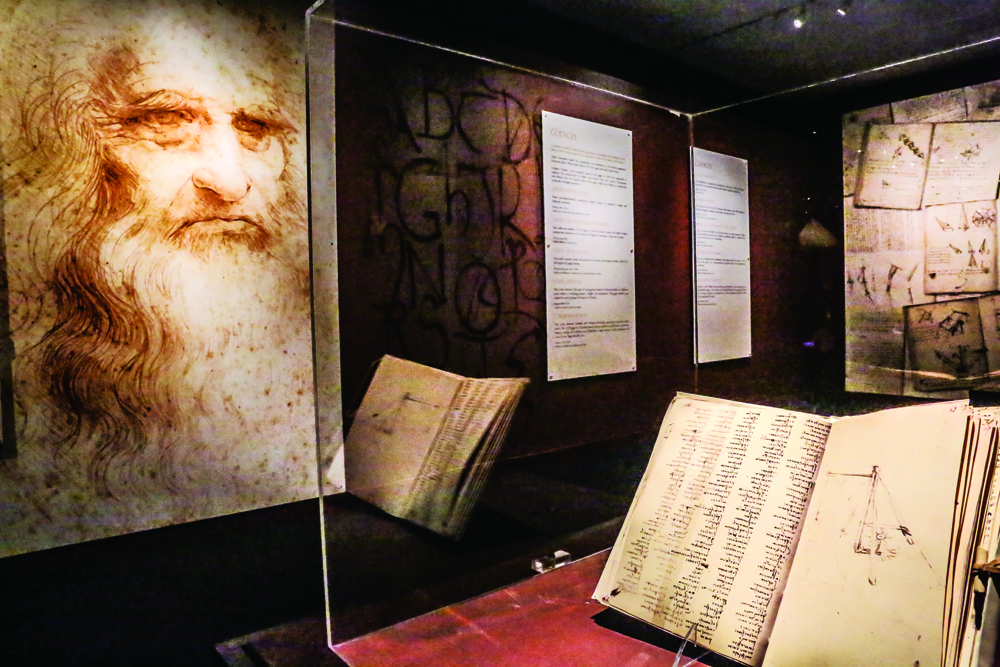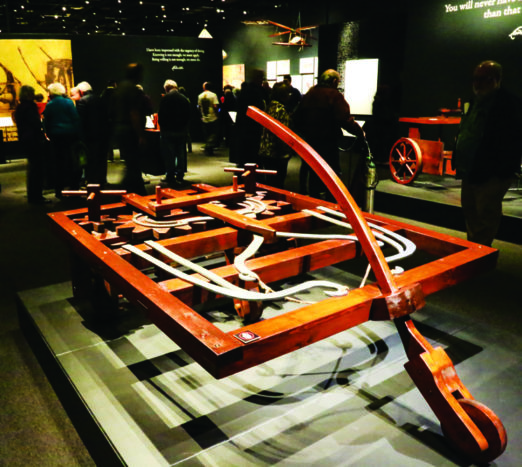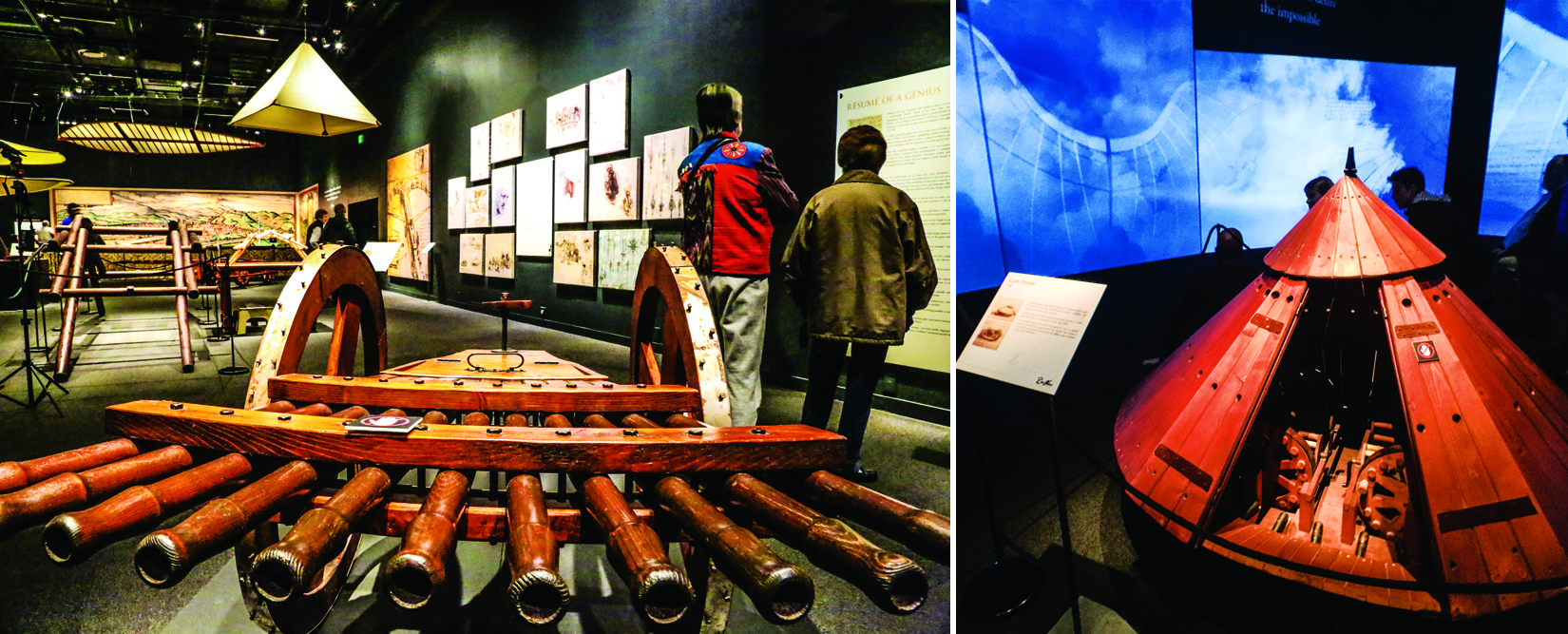
Historical re-enactors in detailed period costumes help visitors step into Leonardo da Vinci’s world and understand everyday life in the sixteenth century at this multisensory exhibit at the Denver Museum of Nature and Science. Above, French actor Ronan Viard portrays François d’Amboise de Cheverny, the envoy assigned by the French governor of Milan to see to Leonardo’s needs while in Milan. Vivard here plays a recorder, but the exhibit features drawings of a double flute Leonardo designed.

Leonardo’s own notebooks or codices guided exhibit organizers as they constructed some of his many creations for this international traveling exhibition. About 6,000 pages of his notes and sketches survive. The exhibit features reproductions of a few of these codices.

TRANSPORTATION — This exhibit of Leonardo’s work includes a number of civil machines. Pictured here is a self-propelled car probably designed for a theatrical production. Other creations include an odometer, an interactive jack, and various styles of cranes along with a maquette of a model city designed to reduce contagion.
Relying on Leonardo da Vinci’s notebooks, the new exhibit at the Denver Museum of Nature and Science features almost 70 of Leonardo’s machines and designs. Many of these never made it to the construction stage in Leonardo’s lifetime, but have been built for this exhibit using the materials and techniques of sixteenth-century craftsmen. Most offer practical solutions to military problems or urban planning challenges, including an assault ladder and an interactive jack and rolling ball bearings. Others seem more esoteric, such as scuba equipment, hand flippers and a life buoy made of leather.

ENGINEERING — Leonardo designed a flywheel to equalize the speed of rotation. Here, a crank would turn until the four spheres rise and the chains are horizontal. In this position, the balls and shaft spin at a constant speed and the effort needed to sustain motion is reduced.
The exhibit on the inventor, artist, anatomist, sculptor, and philosopher who lived from 1452-1519 also features groundbreaking high-resolution images of the Mona Lisa. Scientific engineer and fine arts photographer Pascal Cotte enjoyed rare access to the Mona Lisa at the Louvre. His images, including a 13-foot-high infrared print, reveal the paintings beneath the Mona Lisa and help explain mysteries such as her apparent lack of eyebrows (spoiler alert: she didn’t shave them).

ART — The exhibit features a few reproductions of Leonardo’s paintings, but the Mona Lisa definitely takes center stage. An exclusive feature of the exhibit, “The Secrets of Mona Lisa,” allows visitors to see a 360-degree reproduction of the painting. Pascal Cotte’s super-magnified images of the masterpiece further challenge the public to consider what we think we know about Leonardo’s painting techniques as well as the challenges of conservation.
Australia-based Grande Exhibitions designed the exhibit, but Maura O’Neal, the Museum’s communications manager, shares that the Museum made several unique additions to the Denver exhibition. “We had local craftsmen build the tabletop catapults and other hands-on elements that are part of the exhibition, to allow for a more interactive experience. We also put out a call for local actors to help us bring Renaissance Italy to life.”

ANATOMY— A plasticine arm from the Museum’s permanent collection highlights how much our knowledge of anatomy has grown since Leonardo’s time.The Museum offers a May lecture and lab-based course for those wishing to explore Leonardo’s study of human and animal anatomy.
Historical re-enactors in detailed period costumes enhance the visitor experience. The actors portray individuals representative of diverse segments of society, and include a well-educated court woman and mother (Leonara Strozzi) who sat for a portrait by the master as well as a merchant (Antonio) who creates and sells pigments and art supplies. These characters stroll the “town” and offer a wealth of knowledge about Leonardo and his time. They will not break character as they explain the workings of one of the many inventions or respond to a query about Leonardo’s personal life.

WARFARE — Leonardo created a lot of military designs, though he was himself a pacifist. Left, a mobile, multi-directional “gun machine” designed to fire single or simultaneous rounds at the enemy. A crank at the back allowed adjustments to the height and trajectory of missiles. The “Carro Armato” or tank, right, was designed to move in any direction, with a soldier seated in the turret able to peer outside the armored vehicle to give directions. Eight men could fit inside, and turned cranks to move the large wheels.
Though made in Denver, the re-enactors’ outfits are true to the period. Jennifer Moss Logan, an educator and content specialist in the Museum’s Programs Department, speaks in glowing terms about the costumes designed and made by Museum volunteer Jennifer Wostie. “The details in the pattern of the dress, the silk of the dress…Jennifer researched all of this and everything accurately portrays what a lady of the court or a military man would have worn.”

INTERACTIVE DISPLAYS — Museum guests can test a tabletop catapult, make a self-portrait, and create a codex page. The Museum has also organized a variety of Leonardo-themed programs, including adults-only evenings with grown-up beverages and conversations with curators and scientists.
These efforts, combined with the Renaissance music that plays, help visitors better understand Leonardo’s world. “They allow our guests to put Leonardo in context and step into that space. You can understand Leonardo’s talent and genius along with the everydayness of the time,” says Moss Logan.

MUSIC — This leather harness would allow one to walk while playing music on the miniature piano keyboard.
Leonardo da Vinci: 500 Years of Genius runs through August 25, 2019. The Sturm Family Foundation is the Denver exhibit sponsor. Timed tickets are required and DMNS encourages advance reservations. Tickets are available at dmns.org/davinci or 303.370.6000. All tickets include general admission to the Museum, and Museum members received discounted admission.



0 Comments